| | Apple curculio | Saskatoon sawfly | Wooly elm aphid | Prairie tent caterpillar | Leaf rollers |Saskatoon bud moth | Plant bugs | Cherry shoot borer | Hawthorn lace bug | Cecidomyiid midges | Pear slug
An important part in the production of any fruit crop is to know what type of insects could cause production losses. A crop is at risk throughout the fruiting cycle. Insects can attack plants during flowering, fruit formation or just before harvest of the plump, juicy berries. A successful pest management program includes: insect identification; pest number and damage monitoring; what population numbers warrant control and knowing when the pest can be effectively controlled.
Apple Curculio
(Tachypterellus quadrigibbus)
Identification
- 5 mm long, reddish brown weevil with a long curved snout
Life cycle
- adults appear 5-10 days after petal fall
- adults lay eggs, one per fruit, about 28-33 days after the peak flowering period
- egg laying punctures on the young fruit are at the base close to the stem
- the puncture is sealed with excrement
- larval development takes less than 31 days, pupation less than 7 days
- larva feed on the developing seed in the fruit
- adults emerge from fruit mid July
- adults drop to ground and overwinter in leaf litter
- there appears to be no feeding after emergence
Damage
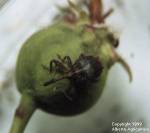
Apple Curculio on a Saskatoon
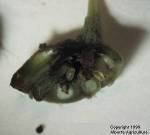
Apple Curculio egg in a
Saskatoon berry
Saskatoon Sawfly
(Hoplocampa montanicola)
Identification
- adults are a 6 mm long sawfly with yellow with brown markings
- mature larvae are 6 mm long with yellow-brown head
Life cycle
- appears in May, just prior to maximum flowering (25% bloom)
- lay eggs in the nectaries of flower blossoms, the position is marked externally by a dark scar along the calyx of the flower
- one egg is laid in each flower
- eggs hatch after petal drop
- the larvae feed on the top of developing fruit
- on average, one larva will ruin 2 fruit per cluster
- the last fruit attacked is completely hollow
- mature larva drop out of the fruit at the end of June
- overwinters in the soil
- pupates in the spring
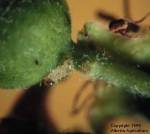
Immature sawfly larva
Damage
- can cause large numbers of fruit to drop
- more than 90% of the potential fruit crop can be lost
- causes fruit to be hollow and mummified
Wooly Elm Aphid
(Eriosoma americanum)
Identification
- blue-black in color with white woolly masses on posterior end
Life cycle
- overwinters on an elm tree as an egg
- the egg hatches into a "stem" mother; which moves to the leaves, where she starts feeding
- without mating, the stem mother gives birth to live young
- while feeding, the aphid injects fluid into the elm leaves, causing the leaves to curl and galls to form
- approximately the time the wild roses and lilacs bloom, aphids move from the elm tree to the roots of the saskatoon and establish colonies there
- in the fall, the aphids return to the elm tree to lay eggs for overwintering
Damage
- heavily infested saskatoons may fail to leaf out in spring
- moderately infested saskatoons may leaf out in spring, but will not grow vigorously
- may have small chlorotic leaves
- once exposed to hot weather, the plants die
- seedlings and plants less than 5 years old seem to be most affected
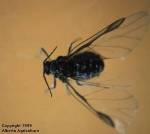
Winged Wooly Elm Aphid
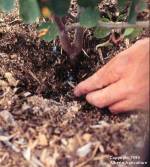
Wooly Elm Aphid in roots of Saskatoon
Prairie Tent Caterpillar
(Malacosoma c. lutescens)
Identification
- adults are stout bodied moths, chocolate brown to dark buff in color with two whitish bands across the front wings
- wingspan of 30-40 mm
- the caterpillar has a black back with a whitish middorsal stripe
- the sides of the caterpillar body are light blue with sparse hairs
- the cocoon is multi-layered and yellowish white
Life cycle
- the eggs are laid at the base of host plant, within 30 cm of ground
- they are covered with a frothy substance
- they hatch in the spring with a flushing of host foliage
- the caterpillar construct silken nest near fork in stem
- when feeding, the caterpillar move out from nests leaving a trail of silk behind
- they return to the nests at night or during bad weather
- they feed for 6-8 weeks, depending on the weather
- then spin a cocoon and emerge in about 3 weeks
- one generation per year
Damage
- the caterpillars spin webbed tents around leaves and branches of host plant
- they feed inside the tent
- repeated defoliation results in a setback of fruit production
Leaf Rollers
(Archips argyrospilus/Choriostoneura rosaceana)
Identification
- a diverse group of moths
- the caterpillar is slender, green to brown, 12 mm in length with a dark-brown or black head
- usually very active and moves backwards when disturbed
Life cycle
- the eggs are laid on leaves
- the larvae change from pale green to greyish brown as they mature
- the larvae roll a leaf around their body to pupate
- could be 2 generations per year
Damage
- holes are eaten in leaves, later the leaves are folded in half and webbed together, which causes the leaves to turn brown and die
- leaf rolling includes the fruit, resulting in lower yields
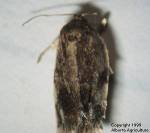
Fruit-tree Leafroller
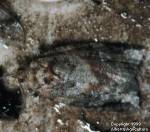
Fruit-tree Leafroller in pupate
Saskatoon Bud Moth
(Epinotia bicordana)
Identification
- the adult is a small greyish-black moth with tinges of brown
- the larva is a light green to whitish worm, with dark head
Life cycle
- adult emerges in April, lays eggs at bud base and in crevices of bark
- larvae hatch in late April to early May
- larvae burrow into the buds around the time of flower bud break (green tip) to tight bud cluster
- they feed on the interior of flower buds
- as the insect matures, they web individual flowers in the flower cluster together and continue feeding
- larva numbers of 1 or more per bud cluster are common
- larva development is complete shortly after the flower petals fall
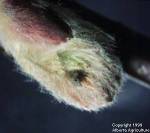
Bud Moth
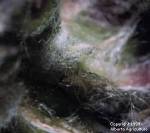
Bud Moth Larva
Plant Bugs
(including the tarnished plant bug Lygus lineolaris)
Identification
- adults are 5-6 mm long, 2.5 mm wide and flattened
- they are pale green to reddish-brown in colour with a distinct triangle or "V" mark 1/3 way down back
- they are difficult to see because they fly or move rapidly
- young nymphs are dull blue-green
- they look similar to aphids, but lack cornicles and move much faster
Life cycle
- adult overwinters under debris or plant cover along fence lines
- in the spring, they feed on early growing plants
- they mate, then migrate to crops suitable for feeding
- egg laying begins as early as mid May (in south) to mid June (in Peace country)
- nymphs develop into adults in 12-34 days, depending on the temperatures -- the hotter the weather, the faster they develop
- they are strong flyers
Damage
- when feeding, the Tarnished Plant Bug punctures the plant tissue and sucks the sap
Cherry Shoot Borer
(Argyresthia oreasella)
Identification
- small, silver white moth with dark gold markings
- present in June and again in late July to mid Aug
- the light green caterpillar is 7 mm when full grown
Life cycle
- overwinters as an egg on leaf buds
- the larva tunnel into young shoots in May
- the larva exits the stem, then pupates
Damage
- late May or early June--new green shoots wither and die
- look for a small hole at the base of the stem and cut open, then look for light a green caterpillar
Hawthorn Lace Bug
(Corythucha cydoniae)
Identification
- the adult is oval or rectangle in shape
- it has a lace-like appearance and the head is covered with a hood
- the larvae are identical to the adults, just smaller
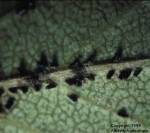
Hawthorn Lace Bug eggs on Saskatoon leaf
Life cycle
- the eggs are laid in early spring on leaf underside
- the eggs hatch in 3 weeks, then the larvae feed on the leaves
- the adults emerge in mid summer
- the second generation completes its development by early fall
- overwinters as adult in leaf litter
Damage
- mottling of foliage
- leaves become leathery and tend to drop prematurely
- will also leave dark, tarry excrement drops on the leaf underside
Cecidomyiid midges
(Cecidomyia sp.)
Identification
- the adult is a slender fly
- the larvae are small, legless maggots
Life cycle
- little is known of the life cycle
Damage
- finger-like galls on the leaves
- they do not cause serious damage to the host plant
Pear Slug
(Caliroa cerasi)
Identification
- green-black, slug-like larva
- adults are a shiny black sawfly and house fly size
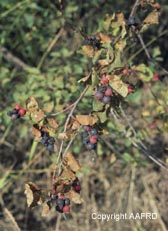
Pear Slug damage to Saskatoon
Life cycle
- two generations per year
- adults lay eggs in slits in leaves
Damage
- larvae rasp away the leaf surface
- skeletonized leaf turns brown and dries up
- feeding damage occurs in June and again in late August
|
|